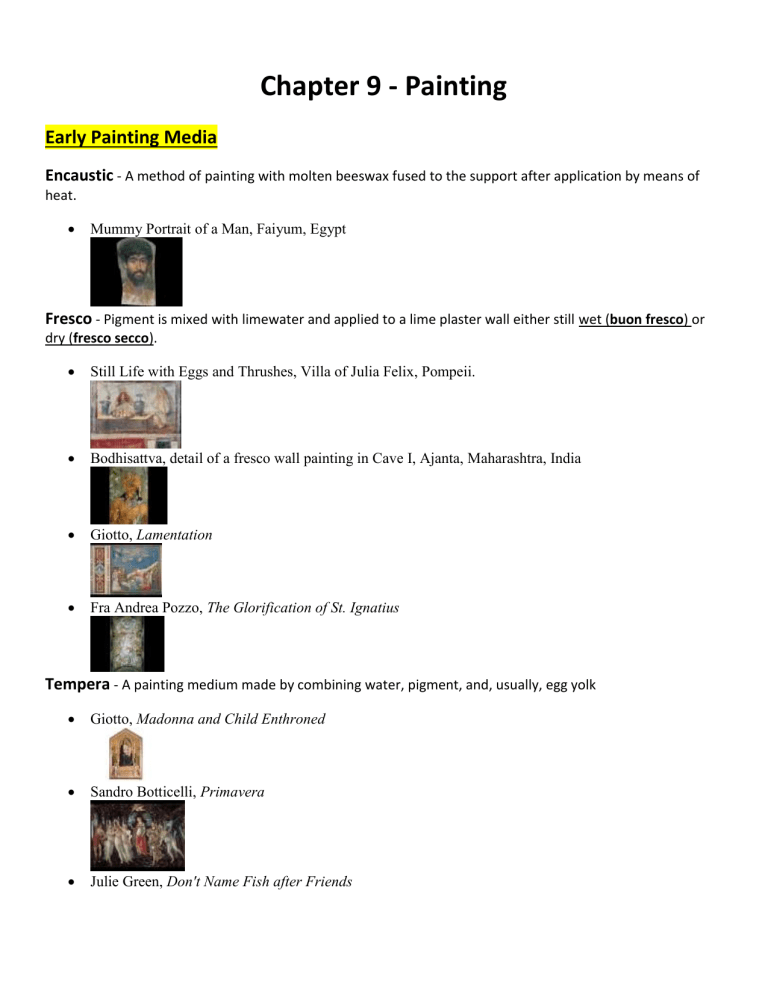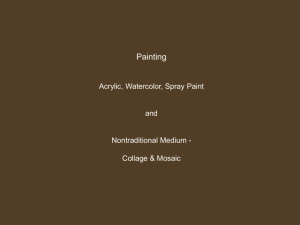
Chapter 9 - Painting Early Painting Media Encaustic - A method of painting with molten beeswax fused to the support after application by means of heat. Mummy Portrait of a Man, Faiyum, Egypt Fresco - Pigment is mixed with limewater and applied to a lime plaster wall either still wet (buon fresco) or dry (fresco secco). Still Life with Eggs and Thrushes, Villa of Julia Felix, Pompeii. Bodhisattva, detail of a fresco wall painting in Cave I, Ajanta, Maharashtra, India Giotto, Lamentation Fra Andrea Pozzo, The Glorification of St. Ignatius Tempera - A painting medium made by combining water, pigment, and, usually, egg yolk Giotto, Madonna and Child Enthroned Sandro Botticelli, Primavera Julie Green, Don't Name Fish after Friends Binders - In a medium, the substances that hold pigment together. Ground - A coating applied to a canvas or printmaking plate to prepare it for painting or etching. Giornata - Literally, “a day’s work,” the area a fresco painter is able to complete in a single sitting. Oil Painting Robert Campin and workshop, The Annunciation (The Mérode Altarpiece). Jan de Heem, Still Life with Lobster o Vanitas Antonio López García, New Refrigerator o Reflects the Vanitas theme Rackstraw Downes, Presidio in the Sand Hills Looking East with ATV Tracks and Water Tower o En Plein Air Characteristics of Oil Painting • • • • • • Creates subtle shading that tempera does not. Creates more realistic paintings (more 3-dimensional) Thinned with turpentine-more transparent Undiluted-impasto Binder-linseed oil (slows drying) Glazing creates a luminous quality Impasto - Paint applied very thickly to canvas or support. Oil Paint’s Superior Expressive Potential Oil paint can record and trace the artist’s presence before the canvas. In fresco, the artist’s gesture is lost in the plaster. In tempera, the artist was forced to use brushed so small that gestural freedom was absorbed by the scale of the image. Josephine Halvorson, Carcass o Expressive Watercolor Winslow Homer, A Wall, Nassau John Marin, Untitled (The Blue Sea). o Watercolor and Charcoal Jacob Lawrence, You can buy bootleg whiskey for twenty-five cents a quart, from the Harlem Series o Gouache John Singer Sargent, Rushing Brook o Gouache The Most Expressive Medium Working quickly, it is possible to achieve gestural effects that are very close to those possible with brush and ink. Artist’s like Homer masters the play between the transparent and opaque qualities of watercolor. In the early 20th century, artists have favored it for realizing more abstract ends. Synthetic Painting Helen Frankenthaler, The Bay o Acrylic Jeremy Deller, A Good Day for Cyclists o Acrylic Kenny Scharf, Mural on Houston Street, SoHo, Manhattan, New York o Spray Paint Advantages of Using Synthetic Painting Materials Acrylic surfaces were durable and well suited for outdoor and indoor spaces. It also dries more quickly than traditional oil paint. Ways Painting Has Combined Itself with Other Media Kara Walker, Insurrection! (Our Tools Were Rudimentary, Yet We Pressed On) Combine-Painting - Robert Rauschenberg’s name for his works of high-relief collage Robert Rauschenberg, Monogram Mixed Media - The combination of two or more media in a single work. Fred Tomaselli, Airborne Event Collage - a work made by pasting various scraps or pieces of material—cloth, paper, photographs—onto the surface of the composition. Juan Gris, The Table Collage Used For Political Goals Because it brings “reality –often photographs of real events and people—into the framed space of the artwork, collage offers artists a direct mean of commenting on the social or political environment in which they work. Martha Rosler, Gladiators, from the series House Beautiful: Bringing the War Home

